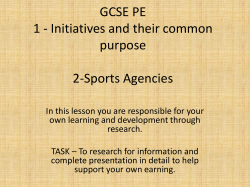
What is a Sport Product?
Introduction to Sport Marketing Lecture 6: Sport Products Lecture 6. Overview Define the term sport product. Outline the key characteristics of sport products. Explain the sport product continuum. Define the term product augmentation, and describe augmentation strategies. Identify the process of new product development. Explain the concept of the product life-cycle. Describe the process of building a sport brand. Product - the first element of the marketing mix What is a Sport Product? A good: a physical item; can be held and touched sport shoes, equipment, memorabilia, apparel A service intangible; not physical objects an experience such as fitness and recreation opportunities, entertainment, physiotherapy, or coaching An idea ideas can form the core of some sport products the idea behind a gym membership could be weight loss or fitness sport stimulates consumers to feel (emotional response) and to believe certain things (thinking response) A combination most sport products are a mixture of tangible and intangible elements Differences between goods and services There are four important differences: 1. Tangibility 2. Consistency 3. Perishability 4. Seperability Tangibility Goods are tangible, physical objects Goods can be taken away and used later Goods can be used repeatedly Services are intangible Services cannot be taken home to keep Services are experienced for a period rather than owned Consistency How reliable the quality of the product is from one time that it is purchased and used to the next Goods are usually highly consistent Sport services have more variable quality Service quality changes depending on who is delivering it and what the conditions are (e.g. weather) Variation in the quality of sport competition can be good Sport marketers should focus their attention on the quality of those parts of the service that they have some control over, like prices, food, beverages, and the venue Perishability Whether a sport product can be stored and used at another time. Sporting goods (like clothing and equipment) are not perishable. Services cannot be stored. Unsold tickets cannot be stored to sell them at another time. Separability Whether the creation or manufacture of a sport product happens at the same time that it is consumed. Sporting goods are made prior to their use. their manufacture and consumption are separated Sport services are made and consumed at the same time. live sport is created at the same time that it is consumed by fans. Principle 6.1: Sport goods may be differentiated from services on the basis of four factors: tangibility, consistency, perishability and separability. Tangibility whether the product is a physical object that can be held and touched Consistency how reliable the quality is from one time to the next Perishability whether the product can be stored and used at another time Separability whether the creation/manufacture happens at the same time that it is consumed Combining tangible and intangible elements Most sport products are a mixture of tangible and intangible elements. Many physical products have a service or idea element. Many services are sold together with something tangible to take away. In many instances, a sport consumer buys a mixture of goods, services, benefits and ideas. Principle 6.2: A sport product is the complete package of benefits presented to a sport consumer in the form of physical goods, services and ideas, or a combination of these in order to produce a sport experience. Many sport products have both tangible and intangible elements. However, some sport products are mainly tangible and some are mainly intangible. sport equipment is mainly tangible Participating in sport is mainly intangible The Sport Product Continuum Many sport products have both tangible and intangible elements. However, some sport products are mainly tangible and some are mainly intangible. sport equipment is mainly tangible participating in sport is mainly intangible The Sport Product Continuum shows that products can be defined along a continuum (or a scale). The Sport Product Continuum Shows that products can be defined along a scale. The Sport Product Continuum Mainly tangible products depend on their physical elements take away the physical object and the product is gone problem: more difficult to differentiate Mainly intangible products depend on the intangible service element take away the service/staff and the product is gone problem: few reminders of product after use A mixture of tangible and intangible e.g. a sport event intangible elements include the match tangible elements include food, beverages and merchandise fans are usually looking for all of these elements Working with the Sport Product Continuum A pivotal tactic in sport marketing is to try to move products away from either of the extremes of the continuum. Try to create a mixture of tangible and intangible elements. Try to add tangible elements to services as reminders. Try to add intangible benefits to goods to differentiate them. Tool 6.1: Sport Product Continuum. The Sport Product Continuum is a useful tool to help show that products can be defined along a continuum (or a scale). The scale shows mainly tangible products on one end, mainly intangible products on the other, and a mixture of the two in the middle. Key Variables of the Sport Product The sport product is a complete package of these elements: Core Benefit The main advantage the consumer gets from using the product. the main benefit of a sport car is transportation the main benefit of a t-shirt is covering for the body It is easy to underestimate the importance of the core benefit. But the core benefit does not meet the needs of sport customers, then it is unlikely to be successful. It is important to understand the main need that the consumer has, or the primary benefit that they get from using the product. Do not add frills to a product if it does not meet the basic needs of consumers in the first place. Actual Product The features of the product the features of a t-shirt include colour, size, fabric and pattern The features of the product can make it stand out against competition. If the core benefit is something that people want, then developing the right features will mould it even more to consumers’ needs. Augmented Product ‘Augmented’ means improved or increased. Any extras or extensions that are added to the actual features of the product. additional benefits, bonus extras a t-shirt may be augmented by adding a bonus cap The status, image or social appeal of a product are all examples of augmentation. a brand image can make a t-shirt more appealing augment a product or the image of a product Product Augmentation Augmentation is important in highly competitive markets. Where products have similar core benefits and product features, augmentation can differentiate them. Many manufacturers like Nike and Adidas use athlete sponsorship to give the product an association with success, exclusivity or style. Principle 6.3: Sport products should be seen as a bundle of benefits comprising the core benefits, actual product features and the augmented product. These product variables are interrelated and should be manipulated as a group. New Product Development Sport marketers often consider new product development. It can be expensive and risky. Only a small fraction of new products are successful. A ‘new product’ can take many forms: a brand new offering improved performance of an existing product new functions added to an existing product new way to use an existing product a new combination of existing products a new look or design for a product Principle 6.4: In sport marketing, a new product can take many forms. the improved performance of an existing product new functions added to an existing product a new way to use an existing product a combination of existing products a new look or design for a product Five Stages of New Product Development New Product Opportunities Collect new product ideas through: market research examining competitors and overseas companies consulting with staff and current customers some new ideas will have emerged in stage one of the Sport Marketing Framework Rank and Prioritise Opportunities Sift through the ideas collected. Keeping those that fit the marketing objectives. Consider how well they fit with existing products. Consider how they relate to current trends. Ignore financial realism at this stage. Select and Test New Products Assess the remaining ideas carefully Pilot the highest ranking options Check feasibility with cost and financial estimates Conduct concept testing give potential customers a product description or prototype and solicit their responses. Devise Product Composition and Marketing Mix Devise product composition: core benefits, actual product features, and augmented product Design other elements of marketing mix: in line with positioning strategy Introduce New Product Release it onto the market. Tool 6.2: New Product Development. The process of new product development involves five stages: 1) 2) 3) 4) 5) Consider New Product Opportunities Rank and Prioritise Opportunities Selection and Testing of New Products Devise Product Composition and Marketing Mix Introduce New Product Product Life Cycle Sport products come and go. Every product has a life-cycle: it is ‘born’, its sales grow, then it may ‘die’ or be up-graded. The term product life-cycle refers to the stages that a product goes through from first being introduced onto the market to its decline. Stages of the Product Life-Cycle Principle 6.5: The term product life-cycle refers to the stages that a product goes through from first being introduced onto the market to its decline. There are four stages of the product life cycle: 1) 2) 3) 4) introduction growth maturity decline Introduction When a product first enters the market. Many products fail or are changed at this stage. Sales and usage increase slowly. May be no profit because of development costs. Marketing costs are usually high because of: the need to advertise to inform consumers the need to give consumers incentives to try the need to give incentives to distributors The length of time in this stage will vary greatly. there may be a long introduction time if there are plenty of other substitute products on the market Growth When the product has attracted the awareness of the target consumers. When there is a rush or increase in sales. Profits usually rise quickly at this stage. Competition also increases. Maturity Once the product has been on the market for a long period. Likely to be more competitors in the marketplace. Producer may be forced to make changes due to competition. Normally the longest stage of the product lifecycle. Profits or usage will gradually decrease. Decline When there is a in sales or usage as an enduring trend. How quickly sales drop will be different for every product and every situation. Eventually the product may be substantially changed or taken off the market. Marketing Strategies During the Life-Cycle Different strategies should be used during different stages of the cycle. Marketing Strategies During the Life-Cycle Tool 6.3: Product Life-cycle Stages. Different marketing strategies should be employed at each stage of a product’s life cycle. Variations should be designed in the marketing mix including: price, promotions, sponsorship, distribution, and services. Sport Branding Branding is closely linked with positioning. A brand is an identifying badge, often reinforced by a name or a logo. It helps consumers recognise a product or an organization. It becomes linked with consumers’ opinions and perceptions of a sport product/organization. Branding, segmentation and positioning strategies should be closely related. Brand Equity Branding helps products to stand out. Branding is a way to augment a product by linking ideas to the product that make it different. The added value that a product possesses because of its brand name and identity is called brand equity. Powerful Brands Powerful brands have a high level of recognition in the market, and strong associated imagery. Principle 6.6: A sport brand is the symbolic representation of everything that a sport organization seeks to stand for, leading to expectations about its value and performance. A brand can be portrayed as an identifying badge which triggers consumers to remember a product or an organization. It can be a name, a design, a symbol (or logo), an image or a combination of these things. Branding is one of the key strategies that marketers use to differentiate their product. Branding is the symbolic representation of positioning, it associates ideas and concepts with the product. Brand Names A brand name is a word, a written label, or even group of letters and/or numbers. It is usually be spoken rather than merely an image. The choice of brand name will symbolise a unique idea. Some brand names might suggest strength and confidence: Others might suggest boldness: If you do not agree with these connotations it means that you hold a different brand identity in your mind. What Makes a Good Brand Name? It should be: Short Positive Easy to remember Easy to say Easy to recognise Unique Able to be registered or trademarked It may also: Describe the product/product use/benefits Translate into other languages Building a Brand Sport branding is more than choosing a memorable name or appealing logo. A brand has to be sold to consumers to elicit the desired reaction. Brands have to be built. There are four steps to brand building: Establish Brand Awareness This is the extent to which consumers recognise and remember a brand name. Consumers must be aware of a brand in order to understand its identity or image. This is a key role of promotion. Develop and Manage the Brand Once awareness is achieved, it is essential to mould consumers perceptions of the brand. Continual efforts to remind consumers of the brand image. Develop and Manage Brand (continued) Consumers perceptions can be managed through these image variables: brand name product features product quality or performance packaging price point advertising promotion sponsorship associations customer service distribution channels Develop Brand Equity Brand equity - the added value that a sport product holds because of its brand name. Consumers will be more loyal if there is high levels of brand equity. Develop Brand Equity (continued) The most important factor to develop equity is perceived quality. Five areas of service quality: reliability, assurance, empathy, responsiveness, and tangibles (addressed lecture 11). Eight features of goods quality: performance, reliability, conformity to specifications, durability, serviceability, aesthetic design and product warranties. Eight Features of Goods Quality Principle 6.8: Brand equity increases when consumers rate products as high quality. There are five elements of service quality: 1) reliability 2) assurance 3) empathy 4) responsiveness 5) tangibles There are eight elements of goods quality: 1) features 2) performance 3) reliability 4) conformity to specifications 5) durability 6) serviceability 7) aesthetic design 8) product warranty Develop Brand Loyalty Brand loyalty - when customers choose it repeatedly in preference to competing brands. Loyalty is developed through: product quality ease of purchase (distribution) loyalty rewards The Power of Brand Olympic Eight attributes most closely associated with the Olympic Games and most important to creating positive regard for the Games: Being the best Dynamic Friendship Eternal Participation Respectful Striving Trustworthy Branding and Licensing Licensing - where a sport organization allows another party to use their brand for a fee. The licensee produces a good, service or promotion, and gives a percentage of sales or a fixed fee to the owner of the brand (licensor). Common in sporting merchandise and apparel. Opportunities and Risks of Licensing Principles Summary Principle 6.1: Sport goods may be differentiated from services on the basis of four factors: tangibility, consistency, perishability and separability. Principle 6.2: A sport product is the complete package of benefits offered to a consumer in the form of physical goods, services and ideas, or a combination of these in order to produce a sport experience. Principle 6.3: Sport products should be seen as a bundle of benefits comprising the core benefits, product features and the augmented product. These three variables are interrelated and should be manipulated as a group. Principle 6.4: In sport marketing, a new product can take many forms such as the improved performance of an existing product, new functions added to an existing product, a new way to use an existing product, combining existing products, or a new look or design for a product. Principle 6.5: ‘Product life-cycle’ refers to the stages that a product goes through from first being introduced onto the market, through growth and maturity to decline. Principle 6.6: A sport brand is the symbolic representation of everything that a sport organization seeks to stand for. It can be a name, a design, a symbol (or logo), an image or a combination of these. Branding is a key strategies that marketers use to position and differentiate their product. Principle 6.7: Building a brand is a process made up of four steps:1) establish brand awareness, 2) develop and manage a brand image, 3) develop brand equity, and 4) develop brand loyalty. Principle 6.8: Brand equity increases when consumers rate products as high quality. There are different elements of product quality for goods compared with services. There are five elements of service quality: 1) reliability, 2) assurance, 3) empathy, 4) responsiveness, and 5) tangibles. There are eight elements of goods quality, these are 1) features, 2) performance, 3) reliability, 4) conformity to specifications, 5) durability, 6) serviceability, 7) aesthetic design and 8) product warranty. Tools Summary Tool 6.1: Sport Product Continuum. Tool 6.2: New Product Development. Tool 6.3: Product Life-cycle Stages.
© Copyright 2025









